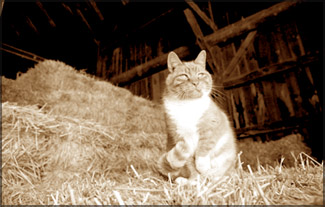
No need to fear the big, bad wolf
In
the story of the three little pigs, the one who built his house of straw
did not fare well; the big, bad wolf huffed and puffed and blew his
house down.
But builder Michael Furbish, who made his own home from bales of
straw and an elementary school of the same material, says in reality,
straw houses are not only sturdy, but also good for the environment.
 Straw
- the stalks of plants like wheat, oats, and barley - is considered a
waste material and is commonly used for farm animal bedding. But more
and more people are discovering that straw baled into rectangular blocks
is an excellent, inexpensive building material. Straw
- the stalks of plants like wheat, oats, and barley - is considered a
waste material and is commonly used for farm animal bedding. But more
and more people are discovering that straw baled into rectangular blocks
is an excellent, inexpensive building material.
"Our mental picture is that a straw bale is light," says Furbish.
"But each bale weighs about 40 pounds (18 kilograms). We stack them like
bricks and then spray plaster - mud, essentially - on the inside walls
to coat them one and a half to two inches (3.8 to 5.1 centimetres)
thick.
Then we put stucco (plaster) on the outside. So a straw building is
really like a fortress, and it is not going to rot as long as water is
kept out of the bales."
There are two ways to make a straw-bale structure. You can build
load-bearing walls with them, which means the walls support the roof. Or
you can build a post-and-beam wooden frame that supports the roof and
fill in the walls with straw bales.
Either way, the walls are there to stay. And they provide great
insulation, helping keep straw homes in cold climates cozy in winter and
those built in hot places like the desert cool in summer.
Straw is considered a "green" (good for the environment) building
material because it is a renewable resource: a whole new crop can be
grown and harvested every year, easily "renewing" the supply.
Also, planting and harvesting straw uses relatively little energy.
"Most other building materials require a lot of energy use in production
and manufacturing at a factory," explains Furbish. "With straw-bale
construction, you are getting a building product without using much
energy at all."
Furbish used about 900 straw bales for his family's two-storey,
three-bedroom house. His company provided straw-bale walls for the
Friends Community School of College Park in Maryland. That project used
about 4,000 bales.
When asked if there are any drawbacks to living in a straw house,
like mice nibbling on the walls, Furbish points out that the straw is
completely covered with plaster and stucco. Besides, he has a couple of
cats on mouse patrol, just in case.
"It would be hard to find a wall system that will outperform straw,"
he says. Looks like the big, bad wolf is just out of luck.
- National
Geographic, Kids NewsFrom Abroad |
